Effects on Bullying at School and Home
VerifiedAdded on 2023/01/16
|17
|4513
|60
AI Summary
This article discusses the effects of bullying at school and home, including its impact on school performance, social relationships, substance abuse, psychological issues, and more. It provides insights into both short term and long term consequences of bullying.
Contribute Materials
Your contribution can guide someone’s learning journey. Share your
documents today.
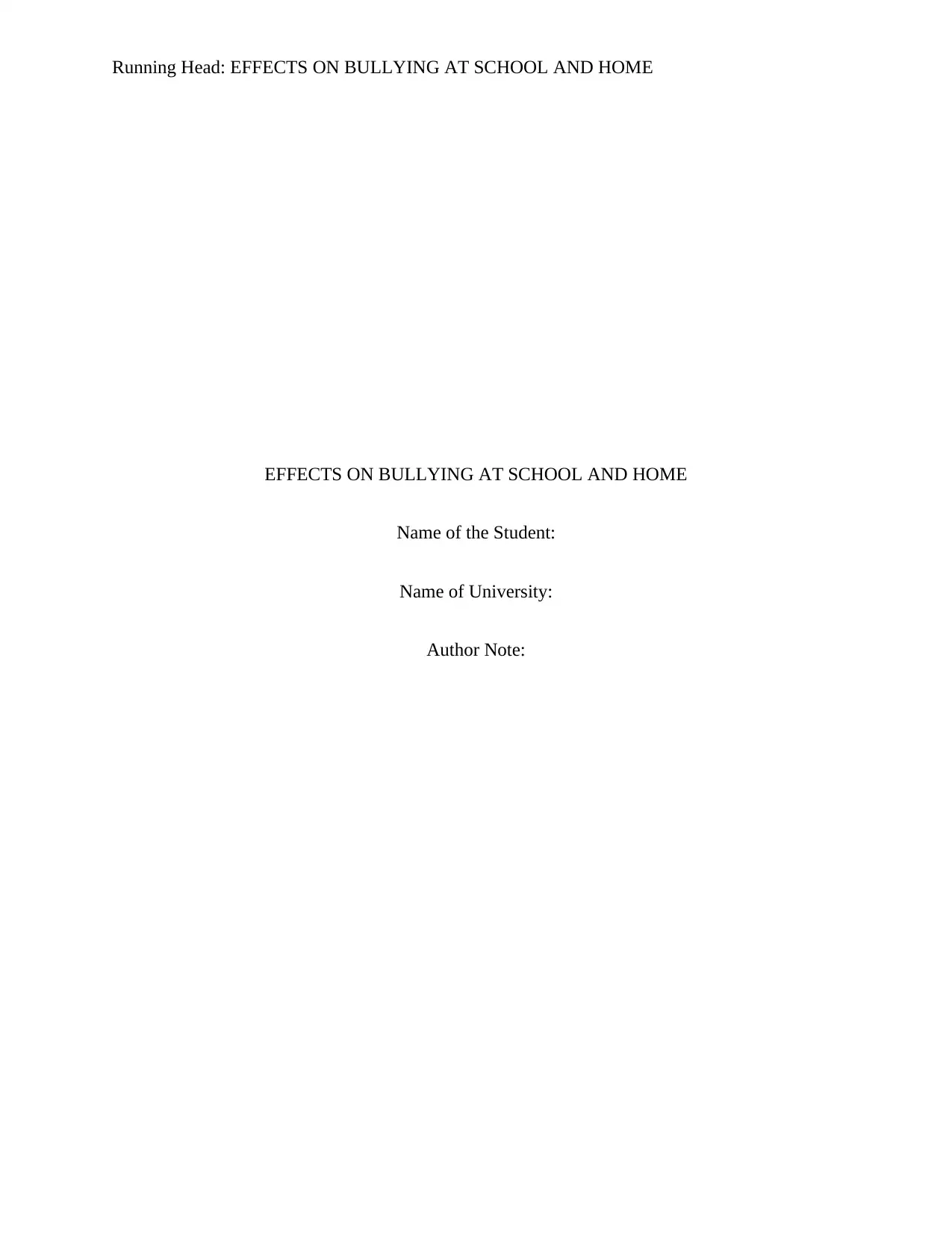
Running Head: EFFECTS ON BULLYING AT SCHOOL AND HOME
EFFECTS ON BULLYING AT SCHOOL AND HOME
Name of the Student:
Name of University:
Author Note:
EFFECTS ON BULLYING AT SCHOOL AND HOME
Name of the Student:
Name of University:
Author Note:
Secure Best Marks with AI Grader
Need help grading? Try our AI Grader for instant feedback on your assignments.

1EFFECTS ON BULLYING AT SCHOOL AND HOME
Table of Contents
Introduction......................................................................................................................................2
Background of Bullying in Canada.................................................................................................2
Effects of bullying...........................................................................................................................4
Short term effects.........................................................................................................................4
Poor school performance.........................................................................................................4
Problem in maintaining social relationships............................................................................4
Increase rate of substance abuse..............................................................................................5
Psychological issue..................................................................................................................5
Problem with sleep..................................................................................................................6
Suicidal issues..........................................................................................................................6
Social isolation.........................................................................................................................6
Low self esteem.......................................................................................................................7
Depression...............................................................................................................................7
Long term effects.........................................................................................................................8
Anxiety disorder......................................................................................................................8
Chronic depression..................................................................................................................9
Risk in substance abuse.........................................................................................................10
Conclusion.....................................................................................................................................11
Reference.......................................................................................................................................12
Table of Contents
Introduction......................................................................................................................................2
Background of Bullying in Canada.................................................................................................2
Effects of bullying...........................................................................................................................4
Short term effects.........................................................................................................................4
Poor school performance.........................................................................................................4
Problem in maintaining social relationships............................................................................4
Increase rate of substance abuse..............................................................................................5
Psychological issue..................................................................................................................5
Problem with sleep..................................................................................................................6
Suicidal issues..........................................................................................................................6
Social isolation.........................................................................................................................6
Low self esteem.......................................................................................................................7
Depression...............................................................................................................................7
Long term effects.........................................................................................................................8
Anxiety disorder......................................................................................................................8
Chronic depression..................................................................................................................9
Risk in substance abuse.........................................................................................................10
Conclusion.....................................................................................................................................11
Reference.......................................................................................................................................12

2EFFECTS ON BULLYING AT SCHOOL AND HOME
Thesis statement: Effect on bullying at school and home
Introduction
Bullying is a systematic abuse of power resembled with the aggressive behaviour and
intentional harm by the peers on the innocent students or the colleagues. There are various types
of bullying leaving different impact on the person. As a result of that it will be very tough to
provide treatment for the victim without having his or her incident. According to Sijtsema et al.
(2014) the direct bullying includes physical and verbal act of aggression such as hitting or
stealing. On the other hand, indirect bullying deal with the characteristics of social exclusion and
rumour spreading. In this context, it is important to understand that bullying is not a disorder or
any kind of mental illness rather it is deliberate and intentional to harm someone. However, the
empirical studies are effectively discussed about the roots of bullying but there is lack of
evidences about its detrimental effects.
Based on this understanding, the purpose of this literature review is to deliver a better
insights into the effects of bullying in terms of both short term and long term. Moreover, the
discussion also intends to develop a rational and relevant explanation in the context of Canada to
address the issue contextually. It can be argued that the role of this research is to identify the
impact of bullies in the long term and short term format. Therefore, both the short term and long
term consequences are incorporated into the discussion with the purpose to make a justifiable
discussion.
Thesis statement: Effect on bullying at school and home
Introduction
Bullying is a systematic abuse of power resembled with the aggressive behaviour and
intentional harm by the peers on the innocent students or the colleagues. There are various types
of bullying leaving different impact on the person. As a result of that it will be very tough to
provide treatment for the victim without having his or her incident. According to Sijtsema et al.
(2014) the direct bullying includes physical and verbal act of aggression such as hitting or
stealing. On the other hand, indirect bullying deal with the characteristics of social exclusion and
rumour spreading. In this context, it is important to understand that bullying is not a disorder or
any kind of mental illness rather it is deliberate and intentional to harm someone. However, the
empirical studies are effectively discussed about the roots of bullying but there is lack of
evidences about its detrimental effects.
Based on this understanding, the purpose of this literature review is to deliver a better
insights into the effects of bullying in terms of both short term and long term. Moreover, the
discussion also intends to develop a rational and relevant explanation in the context of Canada to
address the issue contextually. It can be argued that the role of this research is to identify the
impact of bullies in the long term and short term format. Therefore, both the short term and long
term consequences are incorporated into the discussion with the purpose to make a justifiable
discussion.
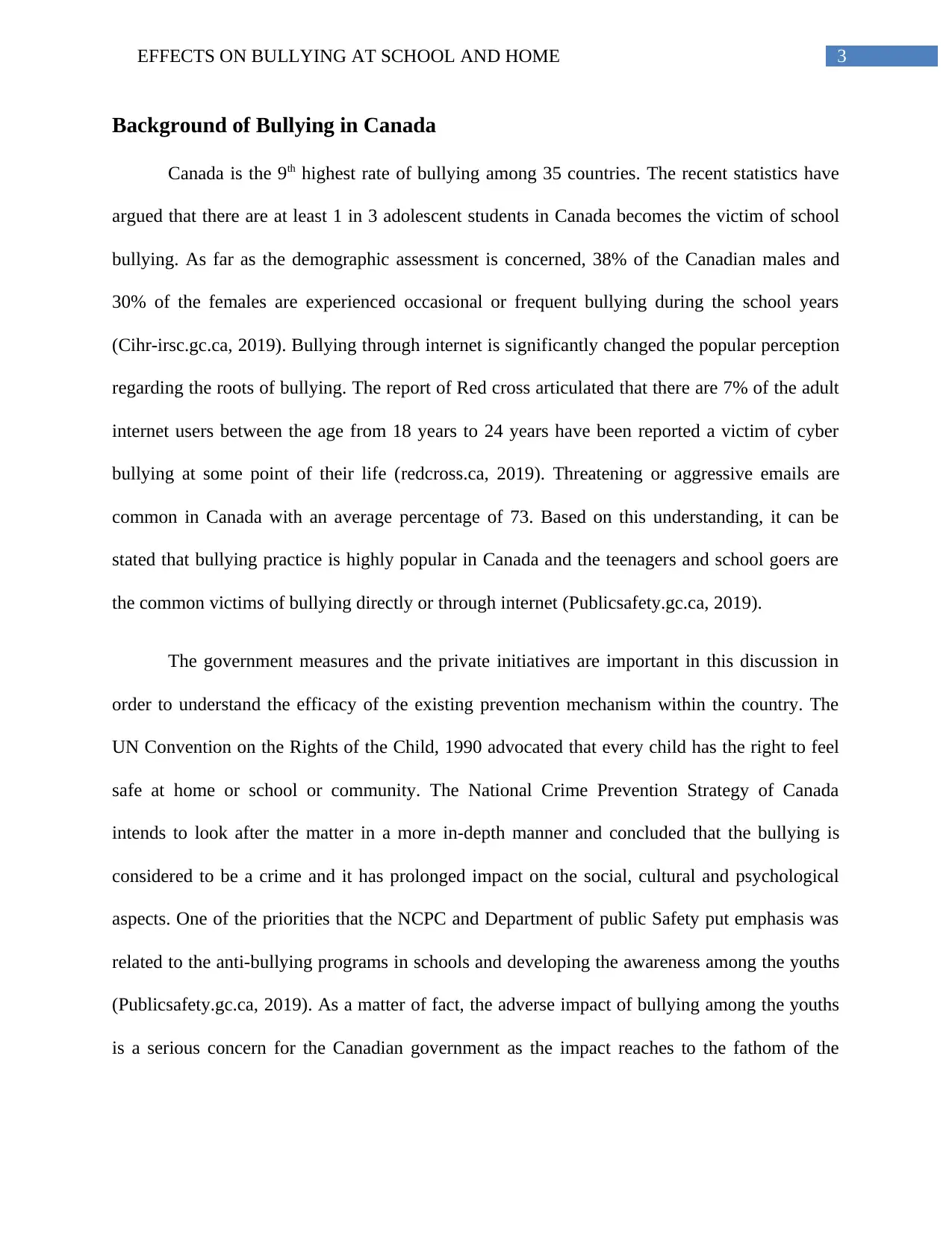
3EFFECTS ON BULLYING AT SCHOOL AND HOME
Background of Bullying in Canada
Canada is the 9th highest rate of bullying among 35 countries. The recent statistics have
argued that there are at least 1 in 3 adolescent students in Canada becomes the victim of school
bullying. As far as the demographic assessment is concerned, 38% of the Canadian males and
30% of the females are experienced occasional or frequent bullying during the school years
(Cihr-irsc.gc.ca, 2019). Bullying through internet is significantly changed the popular perception
regarding the roots of bullying. The report of Red cross articulated that there are 7% of the adult
internet users between the age from 18 years to 24 years have been reported a victim of cyber
bullying at some point of their life (redcross.ca, 2019). Threatening or aggressive emails are
common in Canada with an average percentage of 73. Based on this understanding, it can be
stated that bullying practice is highly popular in Canada and the teenagers and school goers are
the common victims of bullying directly or through internet (Publicsafety.gc.ca, 2019).
The government measures and the private initiatives are important in this discussion in
order to understand the efficacy of the existing prevention mechanism within the country. The
UN Convention on the Rights of the Child, 1990 advocated that every child has the right to feel
safe at home or school or community. The National Crime Prevention Strategy of Canada
intends to look after the matter in a more in-depth manner and concluded that the bullying is
considered to be a crime and it has prolonged impact on the social, cultural and psychological
aspects. One of the priorities that the NCPC and Department of public Safety put emphasis was
related to the anti-bullying programs in schools and developing the awareness among the youths
(Publicsafety.gc.ca, 2019). As a matter of fact, the adverse impact of bullying among the youths
is a serious concern for the Canadian government as the impact reaches to the fathom of the
Background of Bullying in Canada
Canada is the 9th highest rate of bullying among 35 countries. The recent statistics have
argued that there are at least 1 in 3 adolescent students in Canada becomes the victim of school
bullying. As far as the demographic assessment is concerned, 38% of the Canadian males and
30% of the females are experienced occasional or frequent bullying during the school years
(Cihr-irsc.gc.ca, 2019). Bullying through internet is significantly changed the popular perception
regarding the roots of bullying. The report of Red cross articulated that there are 7% of the adult
internet users between the age from 18 years to 24 years have been reported a victim of cyber
bullying at some point of their life (redcross.ca, 2019). Threatening or aggressive emails are
common in Canada with an average percentage of 73. Based on this understanding, it can be
stated that bullying practice is highly popular in Canada and the teenagers and school goers are
the common victims of bullying directly or through internet (Publicsafety.gc.ca, 2019).
The government measures and the private initiatives are important in this discussion in
order to understand the efficacy of the existing prevention mechanism within the country. The
UN Convention on the Rights of the Child, 1990 advocated that every child has the right to feel
safe at home or school or community. The National Crime Prevention Strategy of Canada
intends to look after the matter in a more in-depth manner and concluded that the bullying is
considered to be a crime and it has prolonged impact on the social, cultural and psychological
aspects. One of the priorities that the NCPC and Department of public Safety put emphasis was
related to the anti-bullying programs in schools and developing the awareness among the youths
(Publicsafety.gc.ca, 2019). As a matter of fact, the adverse impact of bullying among the youths
is a serious concern for the Canadian government as the impact reaches to the fathom of the
Secure Best Marks with AI Grader
Need help grading? Try our AI Grader for instant feedback on your assignments.
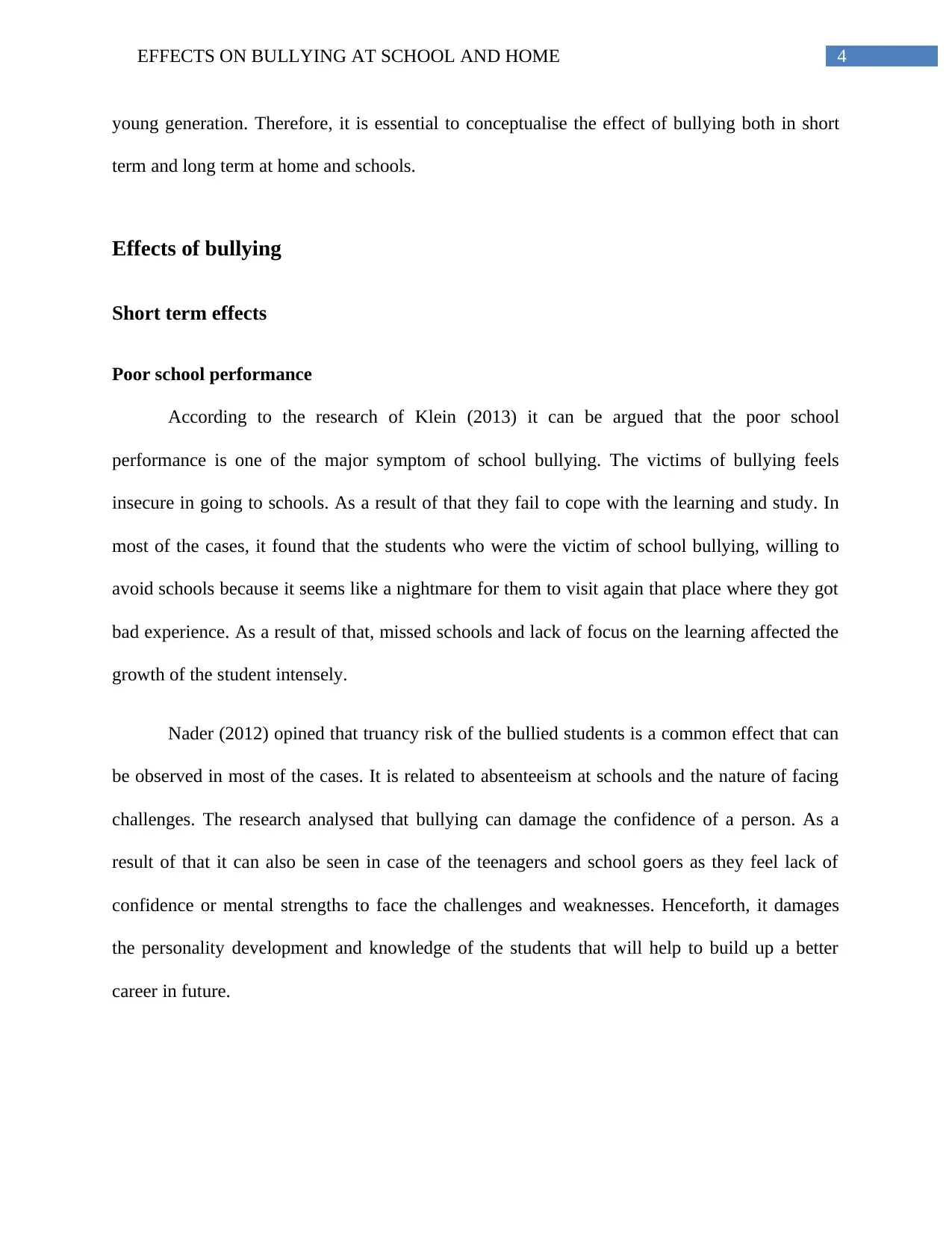
4EFFECTS ON BULLYING AT SCHOOL AND HOME
young generation. Therefore, it is essential to conceptualise the effect of bullying both in short
term and long term at home and schools.
Effects of bullying
Short term effects
Poor school performance
According to the research of Klein (2013) it can be argued that the poor school
performance is one of the major symptom of school bullying. The victims of bullying feels
insecure in going to schools. As a result of that they fail to cope with the learning and study. In
most of the cases, it found that the students who were the victim of school bullying, willing to
avoid schools because it seems like a nightmare for them to visit again that place where they got
bad experience. As a result of that, missed schools and lack of focus on the learning affected the
growth of the student intensely.
Nader (2012) opined that truancy risk of the bullied students is a common effect that can
be observed in most of the cases. It is related to absenteeism at schools and the nature of facing
challenges. The research analysed that bullying can damage the confidence of a person. As a
result of that it can also be seen in case of the teenagers and school goers as they feel lack of
confidence or mental strengths to face the challenges and weaknesses. Henceforth, it damages
the personality development and knowledge of the students that will help to build up a better
career in future.
young generation. Therefore, it is essential to conceptualise the effect of bullying both in short
term and long term at home and schools.
Effects of bullying
Short term effects
Poor school performance
According to the research of Klein (2013) it can be argued that the poor school
performance is one of the major symptom of school bullying. The victims of bullying feels
insecure in going to schools. As a result of that they fail to cope with the learning and study. In
most of the cases, it found that the students who were the victim of school bullying, willing to
avoid schools because it seems like a nightmare for them to visit again that place where they got
bad experience. As a result of that, missed schools and lack of focus on the learning affected the
growth of the student intensely.
Nader (2012) opined that truancy risk of the bullied students is a common effect that can
be observed in most of the cases. It is related to absenteeism at schools and the nature of facing
challenges. The research analysed that bullying can damage the confidence of a person. As a
result of that it can also be seen in case of the teenagers and school goers as they feel lack of
confidence or mental strengths to face the challenges and weaknesses. Henceforth, it damages
the personality development and knowledge of the students that will help to build up a better
career in future.
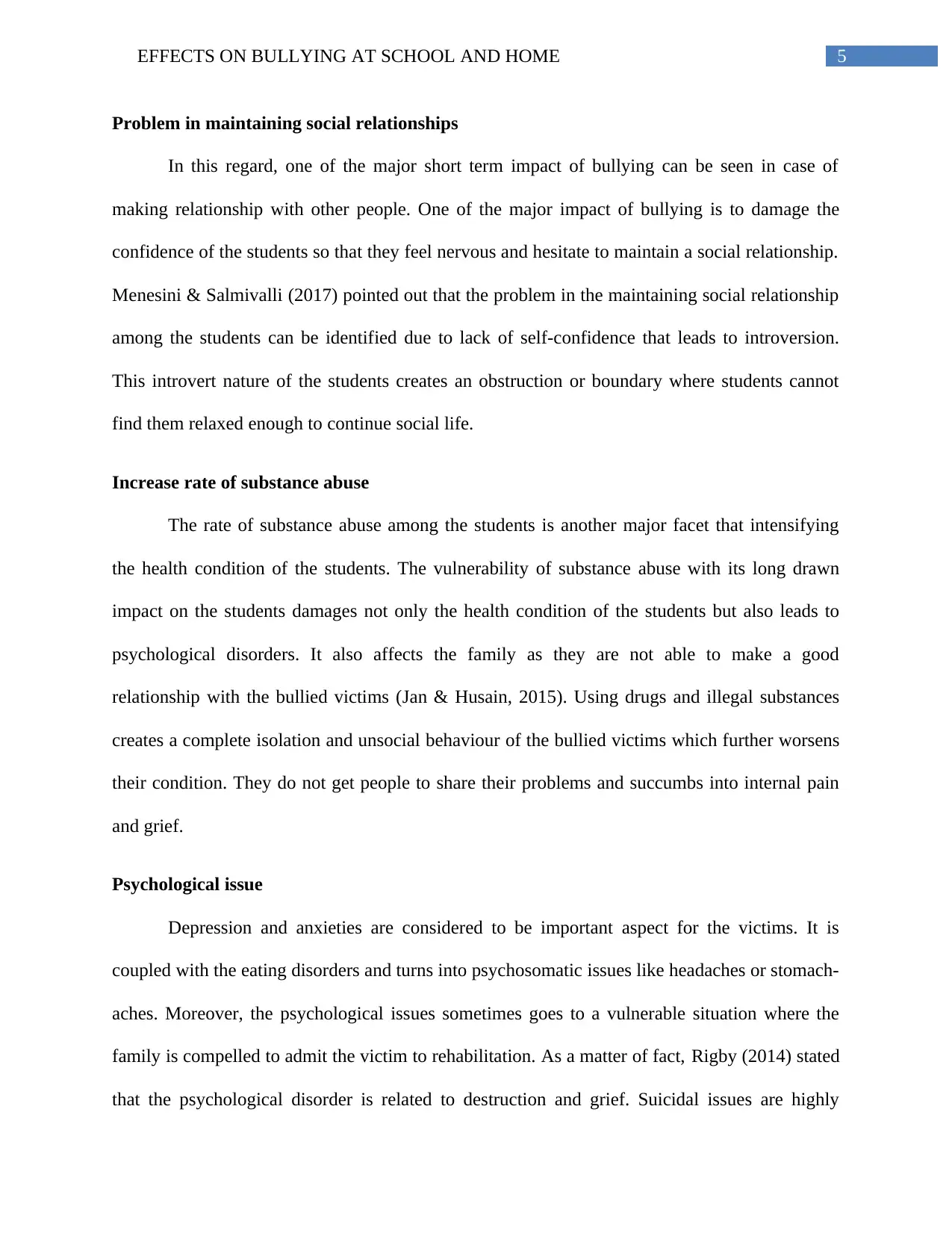
5EFFECTS ON BULLYING AT SCHOOL AND HOME
Problem in maintaining social relationships
In this regard, one of the major short term impact of bullying can be seen in case of
making relationship with other people. One of the major impact of bullying is to damage the
confidence of the students so that they feel nervous and hesitate to maintain a social relationship.
Menesini & Salmivalli (2017) pointed out that the problem in the maintaining social relationship
among the students can be identified due to lack of self-confidence that leads to introversion.
This introvert nature of the students creates an obstruction or boundary where students cannot
find them relaxed enough to continue social life.
Increase rate of substance abuse
The rate of substance abuse among the students is another major facet that intensifying
the health condition of the students. The vulnerability of substance abuse with its long drawn
impact on the students damages not only the health condition of the students but also leads to
psychological disorders. It also affects the family as they are not able to make a good
relationship with the bullied victims (Jan & Husain, 2015). Using drugs and illegal substances
creates a complete isolation and unsocial behaviour of the bullied victims which further worsens
their condition. They do not get people to share their problems and succumbs into internal pain
and grief.
Psychological issue
Depression and anxieties are considered to be important aspect for the victims. It is
coupled with the eating disorders and turns into psychosomatic issues like headaches or stomach-
aches. Moreover, the psychological issues sometimes goes to a vulnerable situation where the
family is compelled to admit the victim to rehabilitation. As a matter of fact, Rigby (2014) stated
that the psychological disorder is related to destruction and grief. Suicidal issues are highly
Problem in maintaining social relationships
In this regard, one of the major short term impact of bullying can be seen in case of
making relationship with other people. One of the major impact of bullying is to damage the
confidence of the students so that they feel nervous and hesitate to maintain a social relationship.
Menesini & Salmivalli (2017) pointed out that the problem in the maintaining social relationship
among the students can be identified due to lack of self-confidence that leads to introversion.
This introvert nature of the students creates an obstruction or boundary where students cannot
find them relaxed enough to continue social life.
Increase rate of substance abuse
The rate of substance abuse among the students is another major facet that intensifying
the health condition of the students. The vulnerability of substance abuse with its long drawn
impact on the students damages not only the health condition of the students but also leads to
psychological disorders. It also affects the family as they are not able to make a good
relationship with the bullied victims (Jan & Husain, 2015). Using drugs and illegal substances
creates a complete isolation and unsocial behaviour of the bullied victims which further worsens
their condition. They do not get people to share their problems and succumbs into internal pain
and grief.
Psychological issue
Depression and anxieties are considered to be important aspect for the victims. It is
coupled with the eating disorders and turns into psychosomatic issues like headaches or stomach-
aches. Moreover, the psychological issues sometimes goes to a vulnerable situation where the
family is compelled to admit the victim to rehabilitation. As a matter of fact, Rigby (2014) stated
that the psychological disorder is related to destruction and grief. Suicidal issues are highly

6EFFECTS ON BULLYING AT SCHOOL AND HOME
common in this context that shattered the career and affected the family directly. An inferiority
complex has grown up that affected the students to deal with the day to day activities and
maintaining social relationships effectively.
Problem with sleep
Sleeping disorder among the bullied students can be identified as one of the major impact
of bullying in schools. As per the report of Hong et al. (2014) it can be argued that bullying
injected a fear in the mind of the students and the effect was so gruesome that it the student could
not overcome it. As a result of that it also affects their sleeping tendencies. Gerlinger and Wo
(2016) remarked that the bullying can left a great deal of impact on the mind of the students so
that they are always afraid of further damage to their life. It puts pressure on their mind as well
and insomniac tendency is the obvious tendency.
Suicidal issues
The relationship between suicide and bullying is a complex matter and often mediated by
different factors like the depression, abuse and self-esteem. As per the research of Burger et al.
(2015) the reason behind such suicidal tendencies is based on the behavioural and emotional
trauma that the students have experienced at an early age through bullying. It also affects the
mental health and the overall well-being of the minors. As a result of that it becomes an
important aspect to evaluate the adverse impact of bullying on students. In addition to this, the
report of Jones and Augustine (2015) remarked that people having suicidal behaviour are going
through an overwhelming feelings of homelessness and hopelessness. Bullying is referred as an
impetus in this practice that intensifies the tendency of suicide and creates risk at school or
home. Therefore, it can be stated that suicide is the most common feature of bullying that should
be restricted and prohibited.
common in this context that shattered the career and affected the family directly. An inferiority
complex has grown up that affected the students to deal with the day to day activities and
maintaining social relationships effectively.
Problem with sleep
Sleeping disorder among the bullied students can be identified as one of the major impact
of bullying in schools. As per the report of Hong et al. (2014) it can be argued that bullying
injected a fear in the mind of the students and the effect was so gruesome that it the student could
not overcome it. As a result of that it also affects their sleeping tendencies. Gerlinger and Wo
(2016) remarked that the bullying can left a great deal of impact on the mind of the students so
that they are always afraid of further damage to their life. It puts pressure on their mind as well
and insomniac tendency is the obvious tendency.
Suicidal issues
The relationship between suicide and bullying is a complex matter and often mediated by
different factors like the depression, abuse and self-esteem. As per the research of Burger et al.
(2015) the reason behind such suicidal tendencies is based on the behavioural and emotional
trauma that the students have experienced at an early age through bullying. It also affects the
mental health and the overall well-being of the minors. As a result of that it becomes an
important aspect to evaluate the adverse impact of bullying on students. In addition to this, the
report of Jones and Augustine (2015) remarked that people having suicidal behaviour are going
through an overwhelming feelings of homelessness and hopelessness. Bullying is referred as an
impetus in this practice that intensifies the tendency of suicide and creates risk at school or
home. Therefore, it can be stated that suicide is the most common feature of bullying that should
be restricted and prohibited.
Paraphrase This Document
Need a fresh take? Get an instant paraphrase of this document with our AI Paraphraser
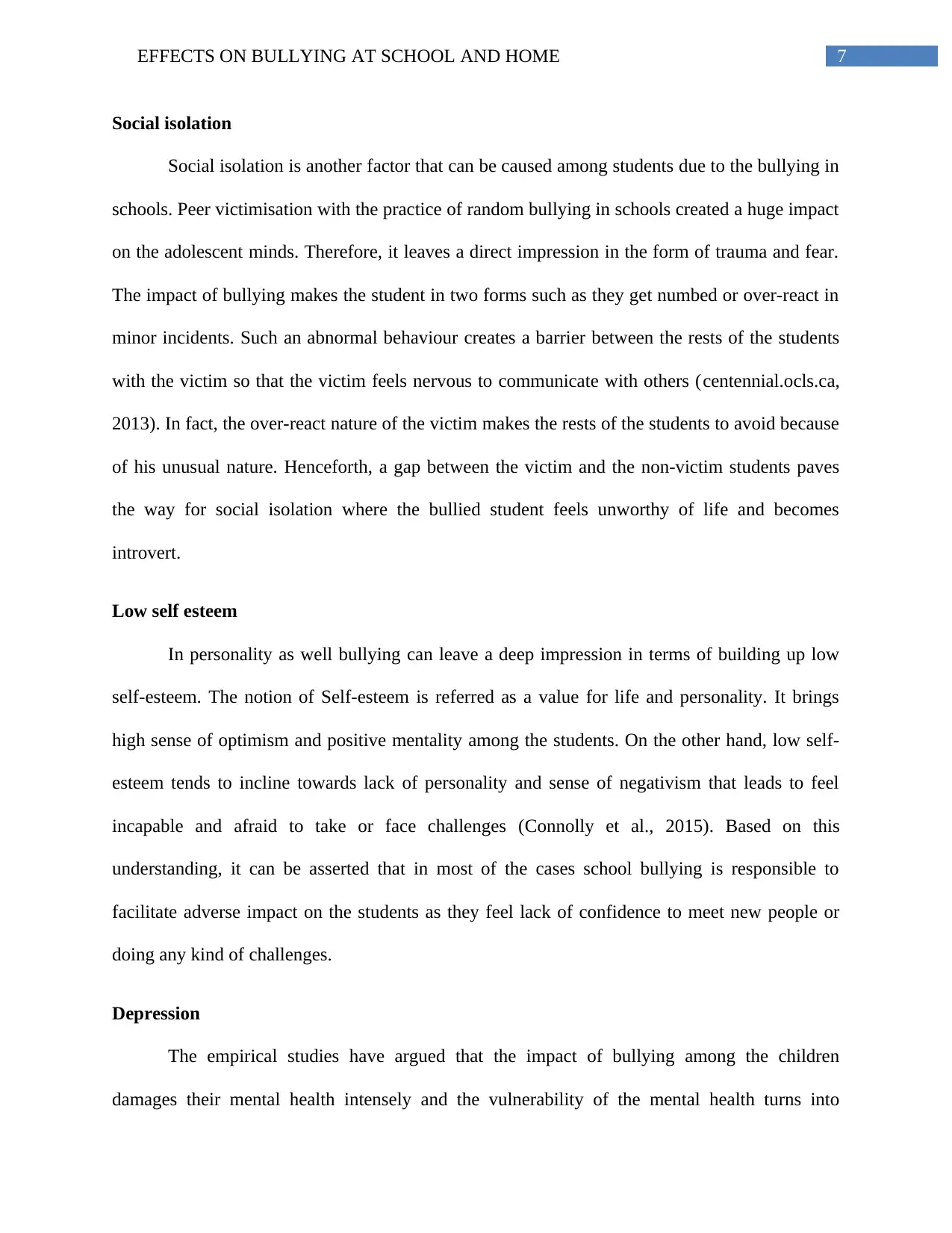
7EFFECTS ON BULLYING AT SCHOOL AND HOME
Social isolation
Social isolation is another factor that can be caused among students due to the bullying in
schools. Peer victimisation with the practice of random bullying in schools created a huge impact
on the adolescent minds. Therefore, it leaves a direct impression in the form of trauma and fear.
The impact of bullying makes the student in two forms such as they get numbed or over-react in
minor incidents. Such an abnormal behaviour creates a barrier between the rests of the students
with the victim so that the victim feels nervous to communicate with others (centennial.ocls.ca,
2013). In fact, the over-react nature of the victim makes the rests of the students to avoid because
of his unusual nature. Henceforth, a gap between the victim and the non-victim students paves
the way for social isolation where the bullied student feels unworthy of life and becomes
introvert.
Low self esteem
In personality as well bullying can leave a deep impression in terms of building up low
self-esteem. The notion of Self-esteem is referred as a value for life and personality. It brings
high sense of optimism and positive mentality among the students. On the other hand, low self-
esteem tends to incline towards lack of personality and sense of negativism that leads to feel
incapable and afraid to take or face challenges (Connolly et al., 2015). Based on this
understanding, it can be asserted that in most of the cases school bullying is responsible to
facilitate adverse impact on the students as they feel lack of confidence to meet new people or
doing any kind of challenges.
Depression
The empirical studies have argued that the impact of bullying among the children
damages their mental health intensely and the vulnerability of the mental health turns into
Social isolation
Social isolation is another factor that can be caused among students due to the bullying in
schools. Peer victimisation with the practice of random bullying in schools created a huge impact
on the adolescent minds. Therefore, it leaves a direct impression in the form of trauma and fear.
The impact of bullying makes the student in two forms such as they get numbed or over-react in
minor incidents. Such an abnormal behaviour creates a barrier between the rests of the students
with the victim so that the victim feels nervous to communicate with others (centennial.ocls.ca,
2013). In fact, the over-react nature of the victim makes the rests of the students to avoid because
of his unusual nature. Henceforth, a gap between the victim and the non-victim students paves
the way for social isolation where the bullied student feels unworthy of life and becomes
introvert.
Low self esteem
In personality as well bullying can leave a deep impression in terms of building up low
self-esteem. The notion of Self-esteem is referred as a value for life and personality. It brings
high sense of optimism and positive mentality among the students. On the other hand, low self-
esteem tends to incline towards lack of personality and sense of negativism that leads to feel
incapable and afraid to take or face challenges (Connolly et al., 2015). Based on this
understanding, it can be asserted that in most of the cases school bullying is responsible to
facilitate adverse impact on the students as they feel lack of confidence to meet new people or
doing any kind of challenges.
Depression
The empirical studies have argued that the impact of bullying among the children
damages their mental health intensely and the vulnerability of the mental health turns into
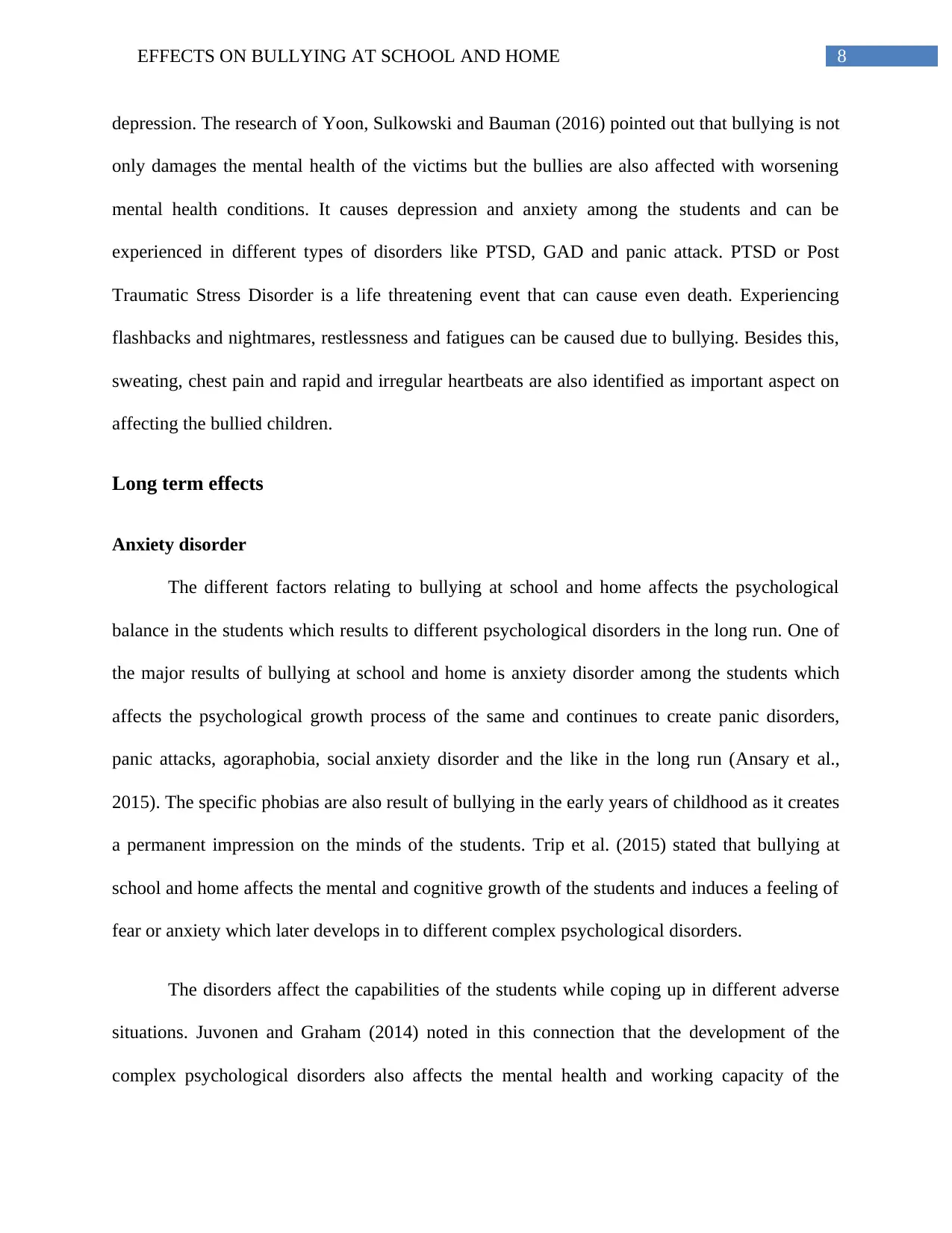
8EFFECTS ON BULLYING AT SCHOOL AND HOME
depression. The research of Yoon, Sulkowski and Bauman (2016) pointed out that bullying is not
only damages the mental health of the victims but the bullies are also affected with worsening
mental health conditions. It causes depression and anxiety among the students and can be
experienced in different types of disorders like PTSD, GAD and panic attack. PTSD or Post
Traumatic Stress Disorder is a life threatening event that can cause even death. Experiencing
flashbacks and nightmares, restlessness and fatigues can be caused due to bullying. Besides this,
sweating, chest pain and rapid and irregular heartbeats are also identified as important aspect on
affecting the bullied children.
Long term effects
Anxiety disorder
The different factors relating to bullying at school and home affects the psychological
balance in the students which results to different psychological disorders in the long run. One of
the major results of bullying at school and home is anxiety disorder among the students which
affects the psychological growth process of the same and continues to create panic disorders,
panic attacks, agoraphobia, social anxiety disorder and the like in the long run (Ansary et al.,
2015). The specific phobias are also result of bullying in the early years of childhood as it creates
a permanent impression on the minds of the students. Trip et al. (2015) stated that bullying at
school and home affects the mental and cognitive growth of the students and induces a feeling of
fear or anxiety which later develops in to different complex psychological disorders.
The disorders affect the capabilities of the students while coping up in different adverse
situations. Juvonen and Graham (2014) noted in this connection that the development of the
complex psychological disorders also affects the mental health and working capacity of the
depression. The research of Yoon, Sulkowski and Bauman (2016) pointed out that bullying is not
only damages the mental health of the victims but the bullies are also affected with worsening
mental health conditions. It causes depression and anxiety among the students and can be
experienced in different types of disorders like PTSD, GAD and panic attack. PTSD or Post
Traumatic Stress Disorder is a life threatening event that can cause even death. Experiencing
flashbacks and nightmares, restlessness and fatigues can be caused due to bullying. Besides this,
sweating, chest pain and rapid and irregular heartbeats are also identified as important aspect on
affecting the bullied children.
Long term effects
Anxiety disorder
The different factors relating to bullying at school and home affects the psychological
balance in the students which results to different psychological disorders in the long run. One of
the major results of bullying at school and home is anxiety disorder among the students which
affects the psychological growth process of the same and continues to create panic disorders,
panic attacks, agoraphobia, social anxiety disorder and the like in the long run (Ansary et al.,
2015). The specific phobias are also result of bullying in the early years of childhood as it creates
a permanent impression on the minds of the students. Trip et al. (2015) stated that bullying at
school and home affects the mental and cognitive growth of the students and induces a feeling of
fear or anxiety which later develops in to different complex psychological disorders.
The disorders affect the capabilities of the students while coping up in different adverse
situations. Juvonen and Graham (2014) noted in this connection that the development of the
complex psychological disorders also affects the mental health and working capacity of the

9EFFECTS ON BULLYING AT SCHOOL AND HOME
students in the long run. Moreover, Warwick and Aggleton (2014) noted that bullying also
results to a sensation of paranoia which develops insecurity among the students. On the other
hand, the development of the anxiety disorder (GAD), affects the capabilities of the students to
cope with different workplace situations in the long run due to their extended fears and anxiety in
facing critical circumstances.
The long term effects of the disorder are headaches, dizziness, and depression which
affects the capabilities of the students in undertaking huge pressure. On the other hand, Sijtsema
et al. (2014) stated that the fear and anxiety affects the mental wellbeing of the students while
getting ingrained in their subconscious mind which gets triggered in critical situations. The
development of the disorder affects the career growth options of the students, as they fail to cope
with adverse circumstances. Therefore, Bullying at school and home leaves a permanent
impression on the minds of the students affecting their capability of coping to different situations
while operating in diverse fields in the long run.
Chronic depression
The bullying at school or home affects the psychological growth of the students resulting
to different forms of depression like Dysthymic disorder or Persistent depressive disorder,
chronic major depression and the like. The different forms of depression affects the mental
stability of the students and results to frequent mood swings and development of suicidal
tendencies. Norwalk et al. (2016) stated that 78% of the bullying cases at school and home leads
to serious chronic depressions affecting the mental health of the afflicted for five or more years.
Bradshaw (2014) also noted that the bullying affects the mental stability and persists in the later
years of career growth. It has been noted that the parents fail to identify depression in their
children in 90% cases, which results to untreated depression and persistence of the same while
students in the long run. Moreover, Warwick and Aggleton (2014) noted that bullying also
results to a sensation of paranoia which develops insecurity among the students. On the other
hand, the development of the anxiety disorder (GAD), affects the capabilities of the students to
cope with different workplace situations in the long run due to their extended fears and anxiety in
facing critical circumstances.
The long term effects of the disorder are headaches, dizziness, and depression which
affects the capabilities of the students in undertaking huge pressure. On the other hand, Sijtsema
et al. (2014) stated that the fear and anxiety affects the mental wellbeing of the students while
getting ingrained in their subconscious mind which gets triggered in critical situations. The
development of the disorder affects the career growth options of the students, as they fail to cope
with adverse circumstances. Therefore, Bullying at school and home leaves a permanent
impression on the minds of the students affecting their capability of coping to different situations
while operating in diverse fields in the long run.
Chronic depression
The bullying at school or home affects the psychological growth of the students resulting
to different forms of depression like Dysthymic disorder or Persistent depressive disorder,
chronic major depression and the like. The different forms of depression affects the mental
stability of the students and results to frequent mood swings and development of suicidal
tendencies. Norwalk et al. (2016) stated that 78% of the bullying cases at school and home leads
to serious chronic depressions affecting the mental health of the afflicted for five or more years.
Bradshaw (2014) also noted that the bullying affects the mental stability and persists in the later
years of career growth. It has been noted that the parents fail to identify depression in their
children in 90% cases, which results to untreated depression and persistence of the same while
Secure Best Marks with AI Grader
Need help grading? Try our AI Grader for instant feedback on your assignments.

10EFFECTS ON BULLYING AT SCHOOL AND HOME
affecting the mental abilities of the children (Smokowski, Evans & Cotter, 2014). Yoon,
Sulkowski and Bauman (2016) note that the untreated depression among the students might
result to enhanced frustration, anxiety, anger and violent behaviour in their later life. On the
other hand, Hong et al. (2014) noted that bullying in school and home affects the mentality of the
students through development of fierceness and revenge mentality. Gerlinger and Wo (2016)
noted that bullying at school develops an indomitable anger among the students apart from the
fear which lasts in the long run, which affects the performance of the students in the different
workplace. On the other hand, it was also noted that bullying affects the perception of the
students which results to a negative mind-set of the same in the long run. The post traumatic
phase revolves around the suicidal tendencies of the students due to anxiety and frustration.
Jones and Augustine (2015) opined that bullying affects the motor skills of the students, which
results to stunted growth and frustration. Chronic major depression affects the capabilities of the
students in coping with different evolving circumstances in the workplace in the long run. On
the other hand, Nader (2012) noted that the evolution of the post-traumatic stress disorder might
result to development of suicidal tendencies among the students. The suicidal tendencies persist
all through the life and different circumstances trigger the same effect among the students in the
later life.
Risk in substance abuse
There is a close connection between bullying and substance abuse. Young people who
have suffered with bullying and peer victimisation are prone to substance abuse. The report of
Ansary et al. (2015) articulated that students who are suffering from trauma due to bullying are
more prone to abuse drugs and alcohol in middle schools in compare to the non-victimise
students. In this regard, there are some risk factors like the peer pressure and lack of parental
affecting the mental abilities of the children (Smokowski, Evans & Cotter, 2014). Yoon,
Sulkowski and Bauman (2016) note that the untreated depression among the students might
result to enhanced frustration, anxiety, anger and violent behaviour in their later life. On the
other hand, Hong et al. (2014) noted that bullying in school and home affects the mentality of the
students through development of fierceness and revenge mentality. Gerlinger and Wo (2016)
noted that bullying at school develops an indomitable anger among the students apart from the
fear which lasts in the long run, which affects the performance of the students in the different
workplace. On the other hand, it was also noted that bullying affects the perception of the
students which results to a negative mind-set of the same in the long run. The post traumatic
phase revolves around the suicidal tendencies of the students due to anxiety and frustration.
Jones and Augustine (2015) opined that bullying affects the motor skills of the students, which
results to stunted growth and frustration. Chronic major depression affects the capabilities of the
students in coping with different evolving circumstances in the workplace in the long run. On
the other hand, Nader (2012) noted that the evolution of the post-traumatic stress disorder might
result to development of suicidal tendencies among the students. The suicidal tendencies persist
all through the life and different circumstances trigger the same effect among the students in the
later life.
Risk in substance abuse
There is a close connection between bullying and substance abuse. Young people who
have suffered with bullying and peer victimisation are prone to substance abuse. The report of
Ansary et al. (2015) articulated that students who are suffering from trauma due to bullying are
more prone to abuse drugs and alcohol in middle schools in compare to the non-victimise
students. In this regard, there are some risk factors like the peer pressure and lack of parental
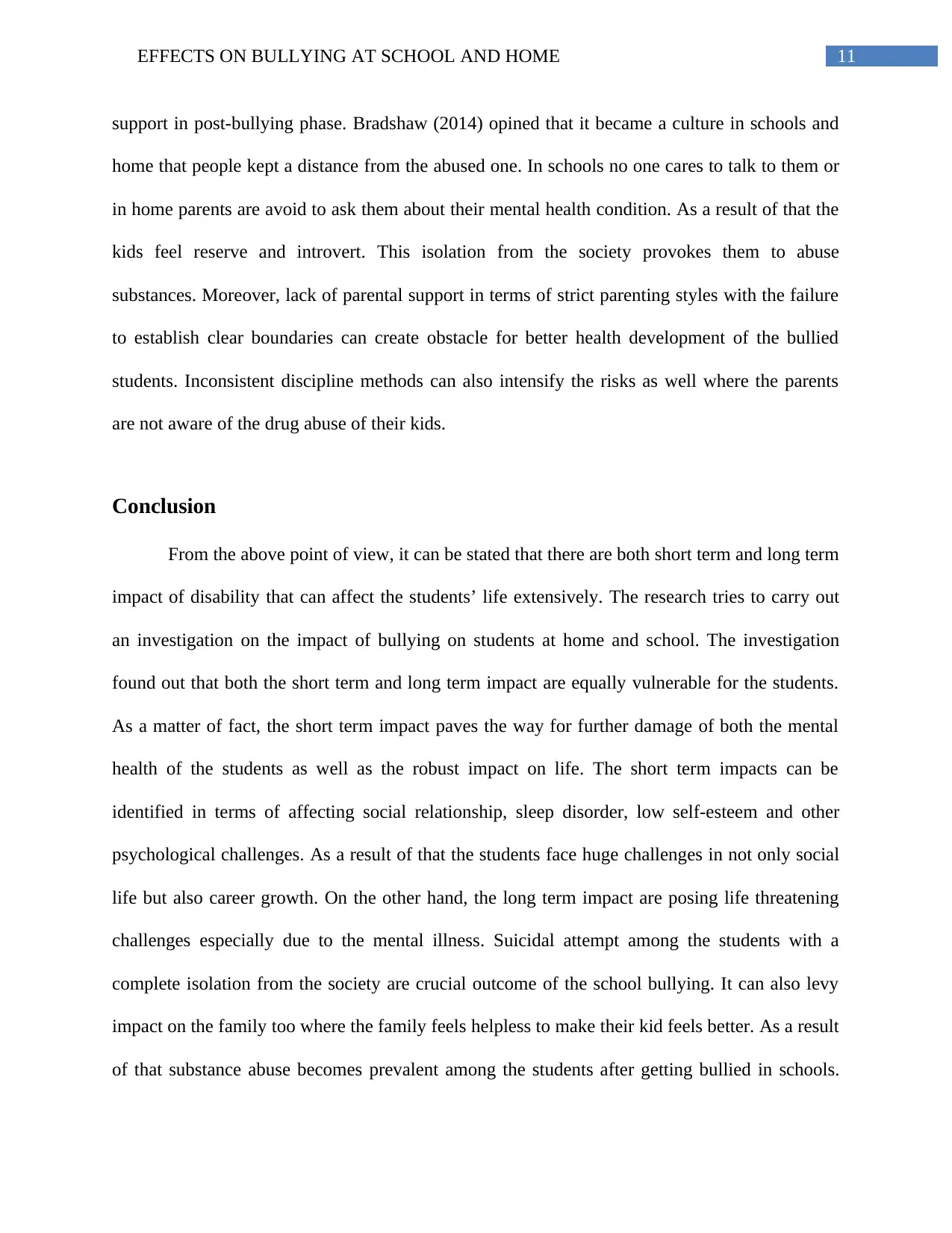
11EFFECTS ON BULLYING AT SCHOOL AND HOME
support in post-bullying phase. Bradshaw (2014) opined that it became a culture in schools and
home that people kept a distance from the abused one. In schools no one cares to talk to them or
in home parents are avoid to ask them about their mental health condition. As a result of that the
kids feel reserve and introvert. This isolation from the society provokes them to abuse
substances. Moreover, lack of parental support in terms of strict parenting styles with the failure
to establish clear boundaries can create obstacle for better health development of the bullied
students. Inconsistent discipline methods can also intensify the risks as well where the parents
are not aware of the drug abuse of their kids.
Conclusion
From the above point of view, it can be stated that there are both short term and long term
impact of disability that can affect the students’ life extensively. The research tries to carry out
an investigation on the impact of bullying on students at home and school. The investigation
found out that both the short term and long term impact are equally vulnerable for the students.
As a matter of fact, the short term impact paves the way for further damage of both the mental
health of the students as well as the robust impact on life. The short term impacts can be
identified in terms of affecting social relationship, sleep disorder, low self-esteem and other
psychological challenges. As a result of that the students face huge challenges in not only social
life but also career growth. On the other hand, the long term impact are posing life threatening
challenges especially due to the mental illness. Suicidal attempt among the students with a
complete isolation from the society are crucial outcome of the school bullying. It can also levy
impact on the family too where the family feels helpless to make their kid feels better. As a result
of that substance abuse becomes prevalent among the students after getting bullied in schools.
support in post-bullying phase. Bradshaw (2014) opined that it became a culture in schools and
home that people kept a distance from the abused one. In schools no one cares to talk to them or
in home parents are avoid to ask them about their mental health condition. As a result of that the
kids feel reserve and introvert. This isolation from the society provokes them to abuse
substances. Moreover, lack of parental support in terms of strict parenting styles with the failure
to establish clear boundaries can create obstacle for better health development of the bullied
students. Inconsistent discipline methods can also intensify the risks as well where the parents
are not aware of the drug abuse of their kids.
Conclusion
From the above point of view, it can be stated that there are both short term and long term
impact of disability that can affect the students’ life extensively. The research tries to carry out
an investigation on the impact of bullying on students at home and school. The investigation
found out that both the short term and long term impact are equally vulnerable for the students.
As a matter of fact, the short term impact paves the way for further damage of both the mental
health of the students as well as the robust impact on life. The short term impacts can be
identified in terms of affecting social relationship, sleep disorder, low self-esteem and other
psychological challenges. As a result of that the students face huge challenges in not only social
life but also career growth. On the other hand, the long term impact are posing life threatening
challenges especially due to the mental illness. Suicidal attempt among the students with a
complete isolation from the society are crucial outcome of the school bullying. It can also levy
impact on the family too where the family feels helpless to make their kid feels better. As a result
of that substance abuse becomes prevalent among the students after getting bullied in schools.
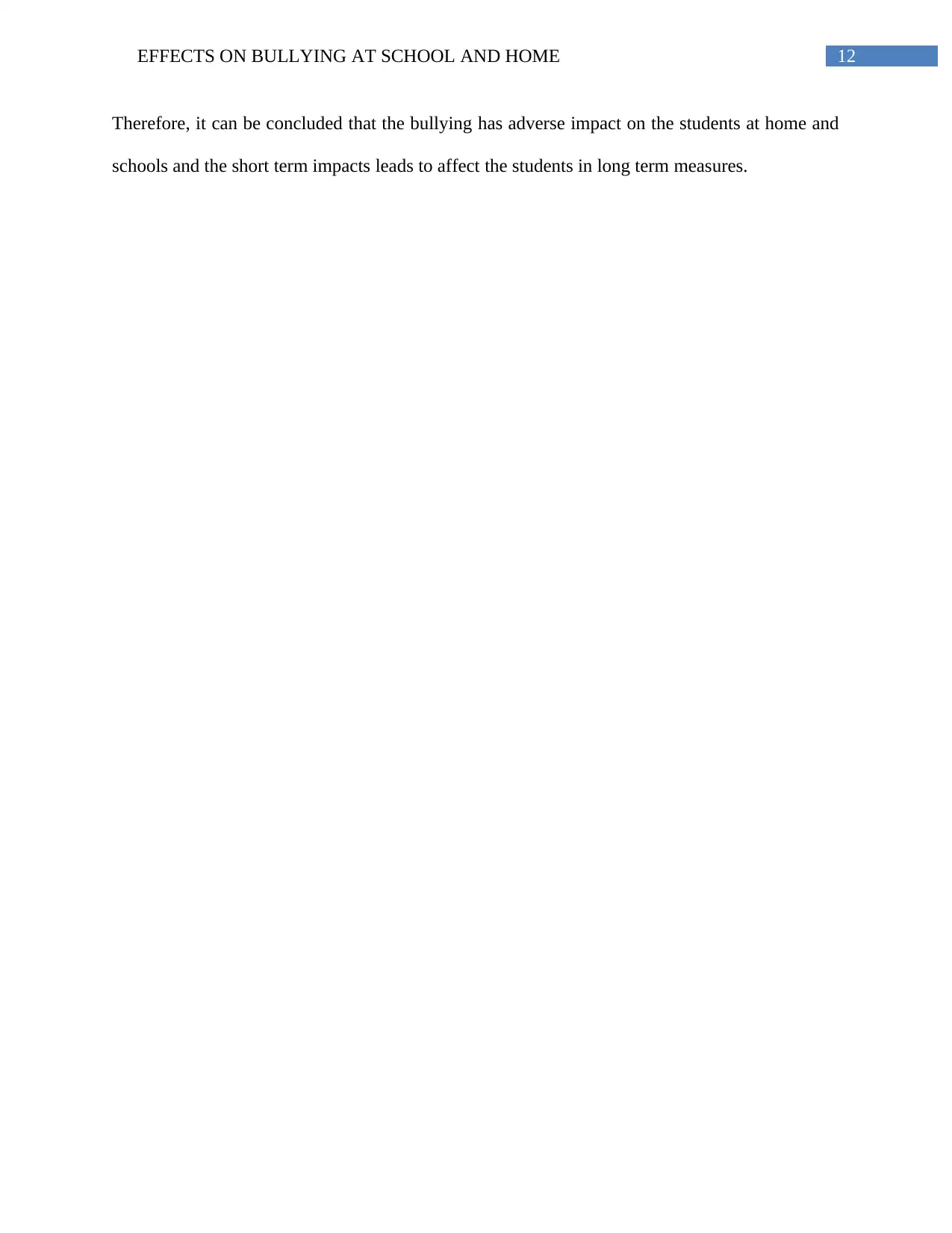
12EFFECTS ON BULLYING AT SCHOOL AND HOME
Therefore, it can be concluded that the bullying has adverse impact on the students at home and
schools and the short term impacts leads to affect the students in long term measures.
Therefore, it can be concluded that the bullying has adverse impact on the students at home and
schools and the short term impacts leads to affect the students in long term measures.
Paraphrase This Document
Need a fresh take? Get an instant paraphrase of this document with our AI Paraphraser
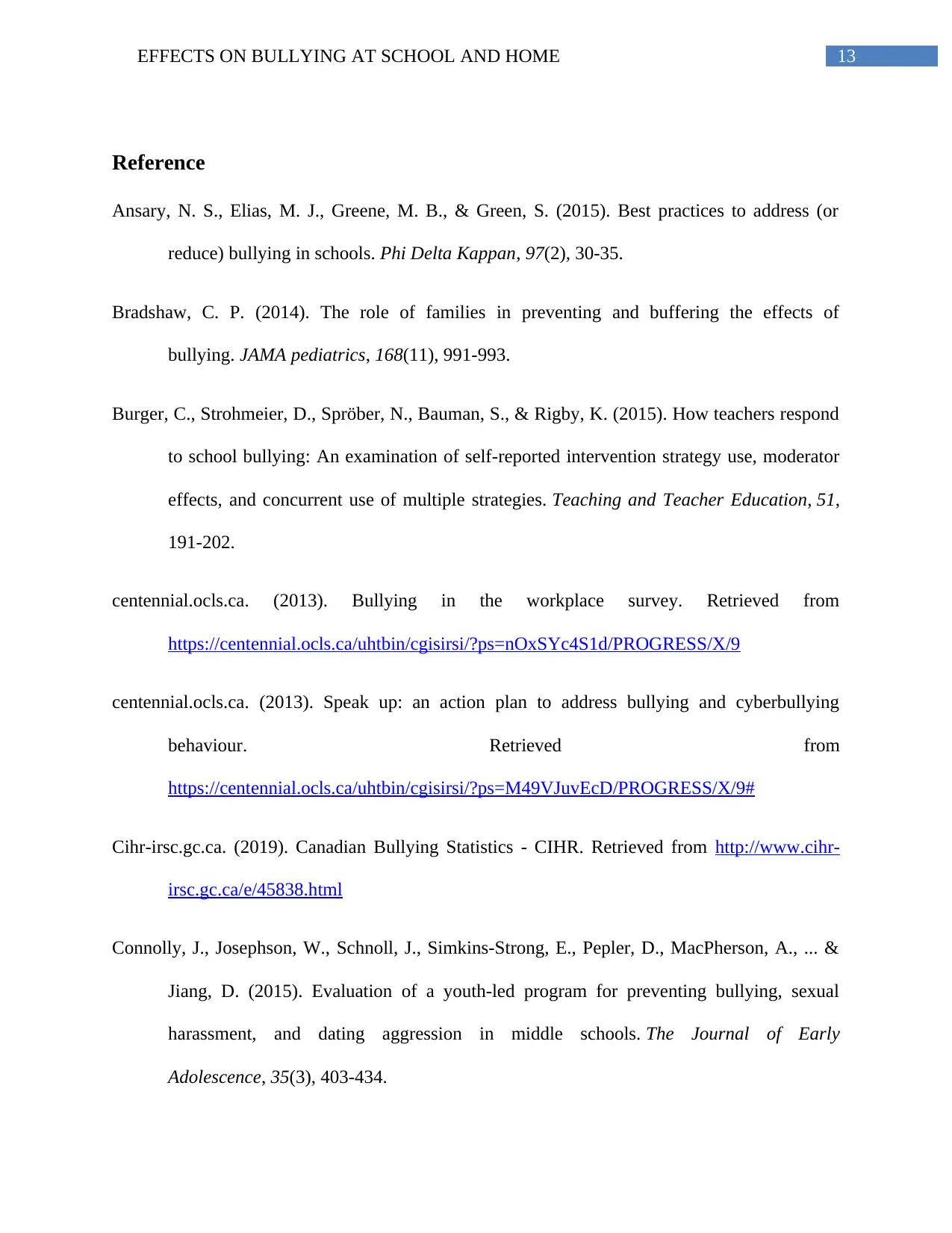
13EFFECTS ON BULLYING AT SCHOOL AND HOME
Reference
Ansary, N. S., Elias, M. J., Greene, M. B., & Green, S. (2015). Best practices to address (or
reduce) bullying in schools. Phi Delta Kappan, 97(2), 30-35.
Bradshaw, C. P. (2014). The role of families in preventing and buffering the effects of
bullying. JAMA pediatrics, 168(11), 991-993.
Burger, C., Strohmeier, D., Spröber, N., Bauman, S., & Rigby, K. (2015). How teachers respond
to school bullying: An examination of self-reported intervention strategy use, moderator
effects, and concurrent use of multiple strategies. Teaching and Teacher Education, 51,
191-202.
centennial.ocls.ca. (2013). Bullying in the workplace survey. Retrieved from
https://centennial.ocls.ca/uhtbin/cgisirsi/?ps=nOxSYc4S1d/PROGRESS/X/9
centennial.ocls.ca. (2013). Speak up: an action plan to address bullying and cyberbullying
behaviour. Retrieved from
https://centennial.ocls.ca/uhtbin/cgisirsi/?ps=M49VJuvEcD/PROGRESS/X/9#
Cihr-irsc.gc.ca. (2019). Canadian Bullying Statistics - CIHR. Retrieved from http://www.cihr-
irsc.gc.ca/e/45838.html
Connolly, J., Josephson, W., Schnoll, J., Simkins-Strong, E., Pepler, D., MacPherson, A., ... &
Jiang, D. (2015). Evaluation of a youth-led program for preventing bullying, sexual
harassment, and dating aggression in middle schools. The Journal of Early
Adolescence, 35(3), 403-434.
Reference
Ansary, N. S., Elias, M. J., Greene, M. B., & Green, S. (2015). Best practices to address (or
reduce) bullying in schools. Phi Delta Kappan, 97(2), 30-35.
Bradshaw, C. P. (2014). The role of families in preventing and buffering the effects of
bullying. JAMA pediatrics, 168(11), 991-993.
Burger, C., Strohmeier, D., Spröber, N., Bauman, S., & Rigby, K. (2015). How teachers respond
to school bullying: An examination of self-reported intervention strategy use, moderator
effects, and concurrent use of multiple strategies. Teaching and Teacher Education, 51,
191-202.
centennial.ocls.ca. (2013). Bullying in the workplace survey. Retrieved from
https://centennial.ocls.ca/uhtbin/cgisirsi/?ps=nOxSYc4S1d/PROGRESS/X/9
centennial.ocls.ca. (2013). Speak up: an action plan to address bullying and cyberbullying
behaviour. Retrieved from
https://centennial.ocls.ca/uhtbin/cgisirsi/?ps=M49VJuvEcD/PROGRESS/X/9#
Cihr-irsc.gc.ca. (2019). Canadian Bullying Statistics - CIHR. Retrieved from http://www.cihr-
irsc.gc.ca/e/45838.html
Connolly, J., Josephson, W., Schnoll, J., Simkins-Strong, E., Pepler, D., MacPherson, A., ... &
Jiang, D. (2015). Evaluation of a youth-led program for preventing bullying, sexual
harassment, and dating aggression in middle schools. The Journal of Early
Adolescence, 35(3), 403-434.
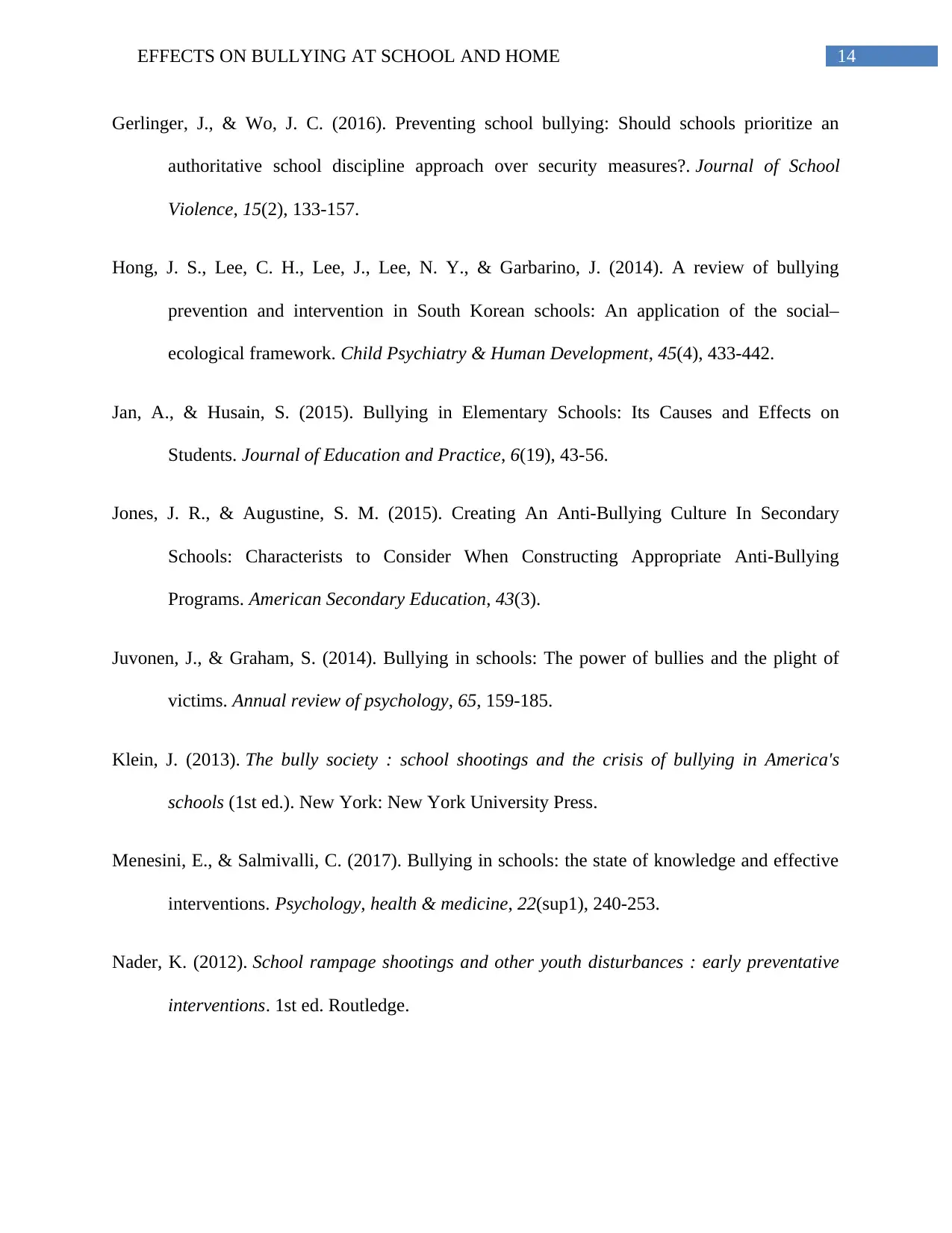
14EFFECTS ON BULLYING AT SCHOOL AND HOME
Gerlinger, J., & Wo, J. C. (2016). Preventing school bullying: Should schools prioritize an
authoritative school discipline approach over security measures?. Journal of School
Violence, 15(2), 133-157.
Hong, J. S., Lee, C. H., Lee, J., Lee, N. Y., & Garbarino, J. (2014). A review of bullying
prevention and intervention in South Korean schools: An application of the social–
ecological framework. Child Psychiatry & Human Development, 45(4), 433-442.
Jan, A., & Husain, S. (2015). Bullying in Elementary Schools: Its Causes and Effects on
Students. Journal of Education and Practice, 6(19), 43-56.
Jones, J. R., & Augustine, S. M. (2015). Creating An Anti-Bullying Culture In Secondary
Schools: Characterists to Consider When Constructing Appropriate Anti-Bullying
Programs. American Secondary Education, 43(3).
Juvonen, J., & Graham, S. (2014). Bullying in schools: The power of bullies and the plight of
victims. Annual review of psychology, 65, 159-185.
Klein, J. (2013). The bully society : school shootings and the crisis of bullying in America's
schools (1st ed.). New York: New York University Press.
Menesini, E., & Salmivalli, C. (2017). Bullying in schools: the state of knowledge and effective
interventions. Psychology, health & medicine, 22(sup1), 240-253.
Nader, K. (2012). School rampage shootings and other youth disturbances : early preventative
interventions. 1st ed. Routledge.
Gerlinger, J., & Wo, J. C. (2016). Preventing school bullying: Should schools prioritize an
authoritative school discipline approach over security measures?. Journal of School
Violence, 15(2), 133-157.
Hong, J. S., Lee, C. H., Lee, J., Lee, N. Y., & Garbarino, J. (2014). A review of bullying
prevention and intervention in South Korean schools: An application of the social–
ecological framework. Child Psychiatry & Human Development, 45(4), 433-442.
Jan, A., & Husain, S. (2015). Bullying in Elementary Schools: Its Causes and Effects on
Students. Journal of Education and Practice, 6(19), 43-56.
Jones, J. R., & Augustine, S. M. (2015). Creating An Anti-Bullying Culture In Secondary
Schools: Characterists to Consider When Constructing Appropriate Anti-Bullying
Programs. American Secondary Education, 43(3).
Juvonen, J., & Graham, S. (2014). Bullying in schools: The power of bullies and the plight of
victims. Annual review of psychology, 65, 159-185.
Klein, J. (2013). The bully society : school shootings and the crisis of bullying in America's
schools (1st ed.). New York: New York University Press.
Menesini, E., & Salmivalli, C. (2017). Bullying in schools: the state of knowledge and effective
interventions. Psychology, health & medicine, 22(sup1), 240-253.
Nader, K. (2012). School rampage shootings and other youth disturbances : early preventative
interventions. 1st ed. Routledge.
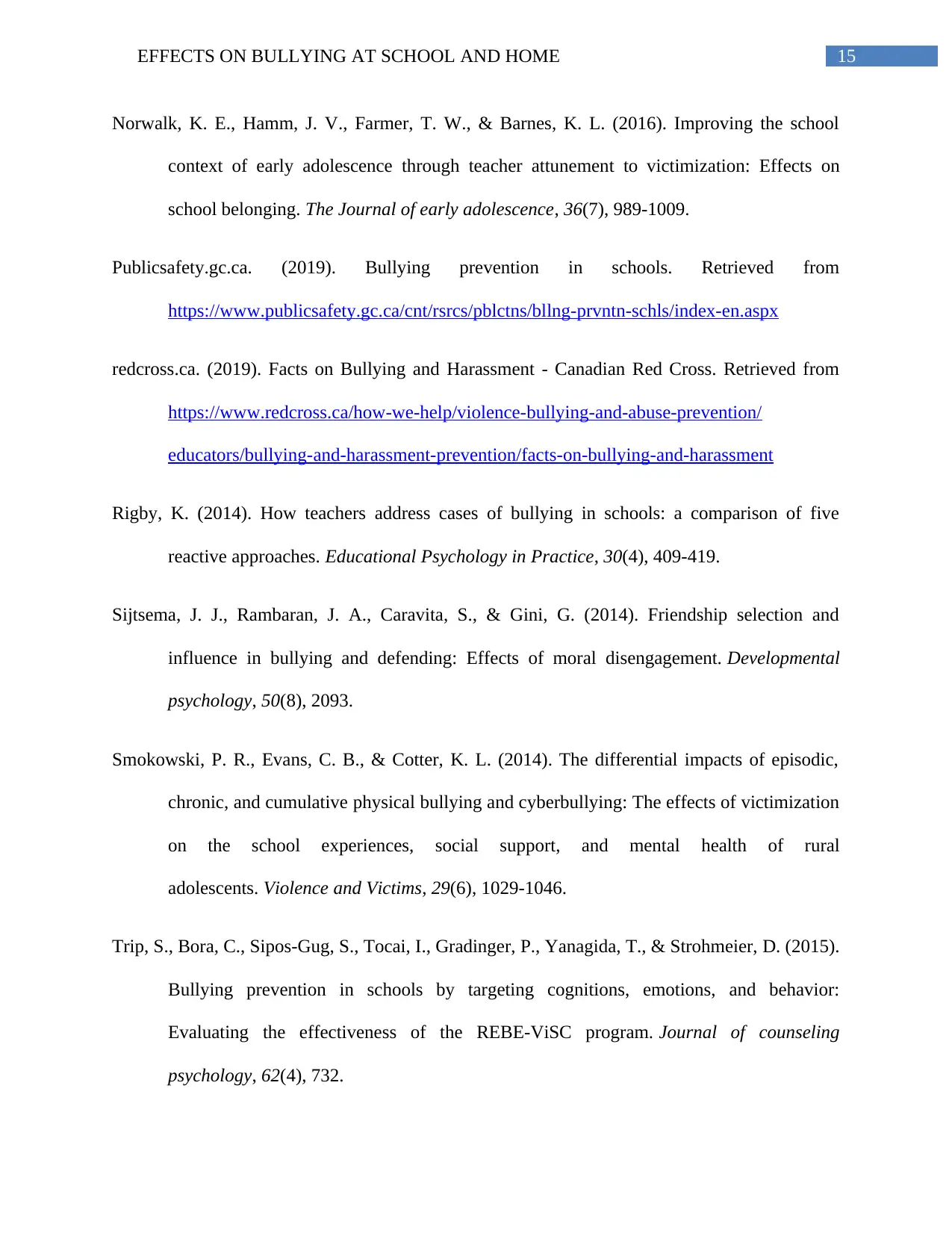
15EFFECTS ON BULLYING AT SCHOOL AND HOME
Norwalk, K. E., Hamm, J. V., Farmer, T. W., & Barnes, K. L. (2016). Improving the school
context of early adolescence through teacher attunement to victimization: Effects on
school belonging. The Journal of early adolescence, 36(7), 989-1009.
Publicsafety.gc.ca. (2019). Bullying prevention in schools. Retrieved from
https://www.publicsafety.gc.ca/cnt/rsrcs/pblctns/bllng-prvntn-schls/index-en.aspx
redcross.ca. (2019). Facts on Bullying and Harassment - Canadian Red Cross. Retrieved from
https://www.redcross.ca/how-we-help/violence-bullying-and-abuse-prevention/
educators/bullying-and-harassment-prevention/facts-on-bullying-and-harassment
Rigby, K. (2014). How teachers address cases of bullying in schools: a comparison of five
reactive approaches. Educational Psychology in Practice, 30(4), 409-419.
Sijtsema, J. J., Rambaran, J. A., Caravita, S., & Gini, G. (2014). Friendship selection and
influence in bullying and defending: Effects of moral disengagement. Developmental
psychology, 50(8), 2093.
Smokowski, P. R., Evans, C. B., & Cotter, K. L. (2014). The differential impacts of episodic,
chronic, and cumulative physical bullying and cyberbullying: The effects of victimization
on the school experiences, social support, and mental health of rural
adolescents. Violence and Victims, 29(6), 1029-1046.
Trip, S., Bora, C., Sipos-Gug, S., Tocai, I., Gradinger, P., Yanagida, T., & Strohmeier, D. (2015).
Bullying prevention in schools by targeting cognitions, emotions, and behavior:
Evaluating the effectiveness of the REBE-ViSC program. Journal of counseling
psychology, 62(4), 732.
Norwalk, K. E., Hamm, J. V., Farmer, T. W., & Barnes, K. L. (2016). Improving the school
context of early adolescence through teacher attunement to victimization: Effects on
school belonging. The Journal of early adolescence, 36(7), 989-1009.
Publicsafety.gc.ca. (2019). Bullying prevention in schools. Retrieved from
https://www.publicsafety.gc.ca/cnt/rsrcs/pblctns/bllng-prvntn-schls/index-en.aspx
redcross.ca. (2019). Facts on Bullying and Harassment - Canadian Red Cross. Retrieved from
https://www.redcross.ca/how-we-help/violence-bullying-and-abuse-prevention/
educators/bullying-and-harassment-prevention/facts-on-bullying-and-harassment
Rigby, K. (2014). How teachers address cases of bullying in schools: a comparison of five
reactive approaches. Educational Psychology in Practice, 30(4), 409-419.
Sijtsema, J. J., Rambaran, J. A., Caravita, S., & Gini, G. (2014). Friendship selection and
influence in bullying and defending: Effects of moral disengagement. Developmental
psychology, 50(8), 2093.
Smokowski, P. R., Evans, C. B., & Cotter, K. L. (2014). The differential impacts of episodic,
chronic, and cumulative physical bullying and cyberbullying: The effects of victimization
on the school experiences, social support, and mental health of rural
adolescents. Violence and Victims, 29(6), 1029-1046.
Trip, S., Bora, C., Sipos-Gug, S., Tocai, I., Gradinger, P., Yanagida, T., & Strohmeier, D. (2015).
Bullying prevention in schools by targeting cognitions, emotions, and behavior:
Evaluating the effectiveness of the REBE-ViSC program. Journal of counseling
psychology, 62(4), 732.
Secure Best Marks with AI Grader
Need help grading? Try our AI Grader for instant feedback on your assignments.
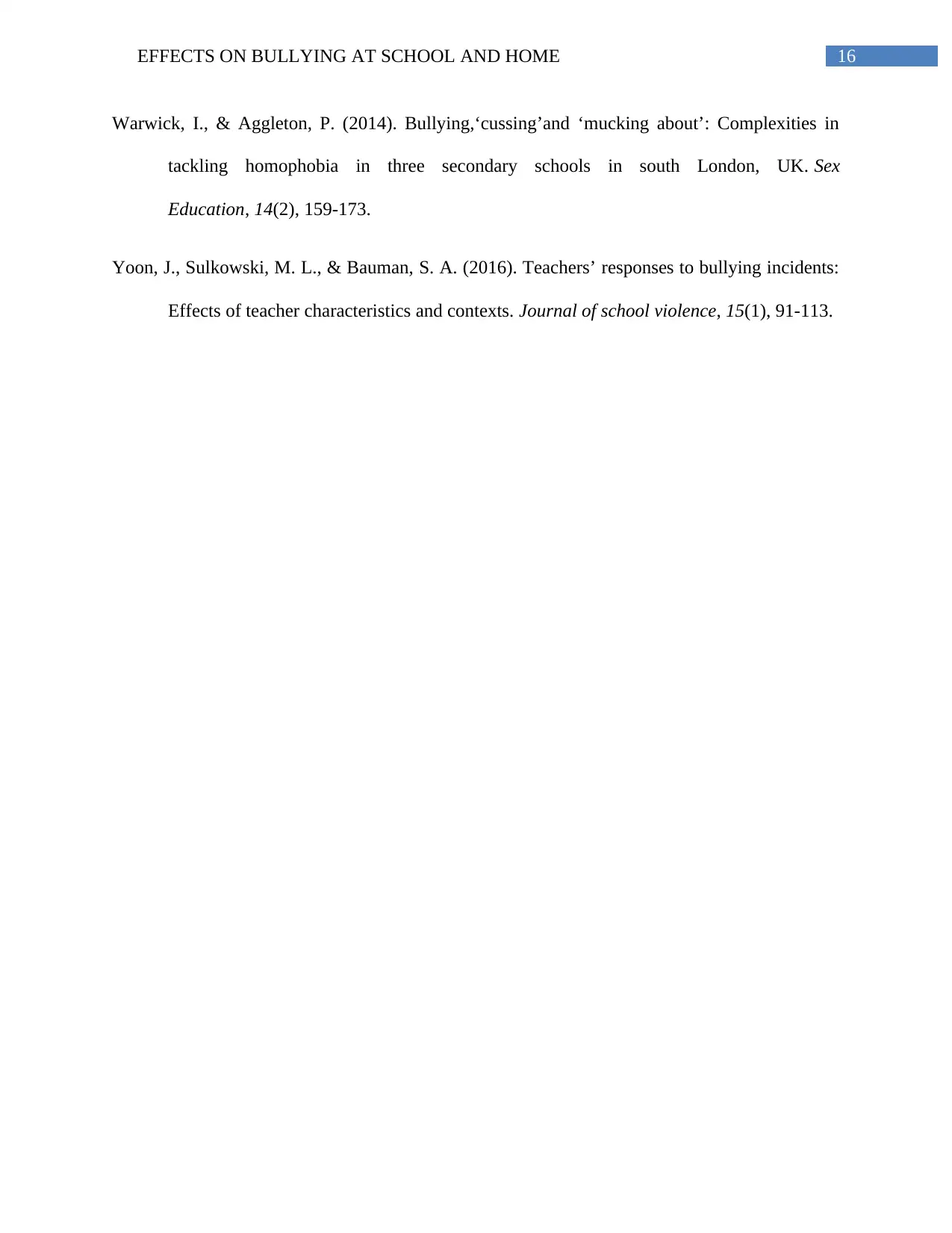
16EFFECTS ON BULLYING AT SCHOOL AND HOME
Warwick, I., & Aggleton, P. (2014). Bullying,‘cussing’and ‘mucking about’: Complexities in
tackling homophobia in three secondary schools in south London, UK. Sex
Education, 14(2), 159-173.
Yoon, J., Sulkowski, M. L., & Bauman, S. A. (2016). Teachers’ responses to bullying incidents:
Effects of teacher characteristics and contexts. Journal of school violence, 15(1), 91-113.
Warwick, I., & Aggleton, P. (2014). Bullying,‘cussing’and ‘mucking about’: Complexities in
tackling homophobia in three secondary schools in south London, UK. Sex
Education, 14(2), 159-173.
Yoon, J., Sulkowski, M. L., & Bauman, S. A. (2016). Teachers’ responses to bullying incidents:
Effects of teacher characteristics and contexts. Journal of school violence, 15(1), 91-113.
1 out of 17
Related Documents
Your All-in-One AI-Powered Toolkit for Academic Success.
+13062052269
info@desklib.com
Available 24*7 on WhatsApp / Email
![[object Object]](/_next/static/media/star-bottom.7253800d.svg)
Unlock your academic potential
© 2024 | Zucol Services PVT LTD | All rights reserved.





